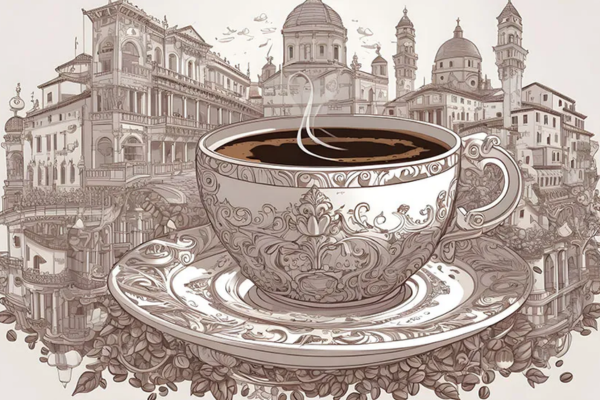
Coffee is more than just a daily ritual—it carries with it centuries of stories, myths, and cultural traditions. Behind every cup of coffee, there are tales of discovery, adventure, hardship, and community. Each coffee-producing region has its own fascinating stories that reflect the unique relationship between the people and the land where coffee is grown.
From the mountains of Ethiopia to the lush plantations of Brazil, these stories offer a glimpse into the lives of those who cultivate coffee and the histories that have shaped the global coffee industry. In this article, we’ll explore some of the most intriguing tales from coffee-producing regions, revealing the rich cultural fabric behind your daily brew.
1. Ethiopia: The Birthplace of Coffee and the Legend of Kaldi
Ethiopia, often considered the birthplace of coffee, is home to one of the most famous coffee legends. The story of Kaldi, the goat herder, dates back to the 9th century. According to legend, Kaldi noticed that his goats became unusually energetic after eating the red cherries from a particular bush. Intrigued by their behavior, he tried the cherries himself and felt a sudden burst of energy.
Kaldi shared his discovery with a local monk, who initially dismissed the berries as suspicious. However, after using the berries to brew a drink, the monk found that it helped him stay awake during long prayer sessions. The news of this energizing beverage quickly spread through the region and beyond, marking the beginning of coffee’s incredible journey.
Ethiopia’s coffee culture remains rich and vibrant today. The Ethiopian coffee ceremony is a communal ritual that symbolizes hospitality, friendship, and respect. During this ceremony, green coffee beans are roasted, ground, and brewed in a traditional clay pot called a “jebena”. The experience reflects the deep cultural and historical significance of coffee in Ethiopia.
2. Yemen: The Sufi Mystics and the Port of Mocha
Yemen played a crucial role in transforming coffee from a regional curiosity into a global commodity. In the 15th century, coffee was cultivated and consumed by Sufi mystics who used it to stay awake during their nocturnal prayers. The drink, known as “qahwa,” became an essential part of their spiritual practices.
The Yemeni port city of Mocha became a major hub for the coffee trade, giving its name to the now-famous coffee-chocolate drink. Traders exported Yemeni coffee beans to the Middle East, North Africa, and eventually Europe. The distinct flavor of Mocha coffee, grown in the highlands of Yemen, became highly sought after.
A fascinating tale from this period involves the spread of coffee plants. According to legend, a Sufi monk named Baba Budan smuggled seven coffee seeds out of Yemen by strapping them to his chest. He planted the seeds in Chikmagalur, India, leading to the establishment of coffee cultivation in Asia.
Yemen’s coffee history is a testament to the resilience and ingenuity of its people. Despite challenges like water scarcity and political turmoil, Yemeni coffee remains prized for its rich, complex flavors and historical significance.
3. Brazil: The Smuggler’s Seeds and the Rise of a Coffee Empire
Brazil is the world’s largest coffee producer, but its coffee journey began with a daring act of smuggling. In 1727, a Portuguese officer named Francisco de Melo Palheta was sent to French Guiana on a diplomatic mission. His real mission, however, was to obtain coffee seeds for Brazil.
Legend has it that Palheta charmed the French governor’s wife, who secretly gave him a bouquet containing hidden coffee seeds. Upon returning to Brazil, Palheta planted the seeds, and coffee cultivation quickly spread throughout the country. The favorable climate and fertile soil allowed coffee plantations to thrive, particularly in the regions of Minas Gerais, São Paulo, and Espírito Santo.
By the 19th century, coffee had become Brazil’s most important export, shaping its economy and social structure. The rise of coffee plantations relied heavily on slave labor, a dark chapter in Brazil’s coffee history. After the abolition of slavery in 1888, coffee production continued to grow, supported by waves of immigrant labor.
Today, Brazil’s coffee culture is celebrated worldwide. The country is known for its “cafézinho”—a small, strong cup of coffee served throughout the day as a gesture of hospitality.
4. Colombia: The Resilient Spirit of Coffee Farmers
Colombia is renowned for its high-quality coffee, thanks to its ideal growing conditions and the dedication of its coffee farmers, known as “cafeteros.” The story of Colombian coffee is one of resilience, community, and pride.
In the early 20th century, Colombia’s coffee industry faced numerous challenges, including difficult terrain, poor infrastructure, and political instability. Despite these obstacles, Colombian farmers continued to produce coffee with remarkable consistency and quality.
A key figure in Colombia’s coffee narrative is Juan Valdez, a fictional character created in 1958 by the National Federation of Coffee Growers of Colombia. Juan Valdez, depicted as a humble farmer with his mule, Conchita, became a symbol of the hardworking Colombian cafetero. The campaign successfully promoted Colombian coffee as a premium product, recognized for its smooth, balanced flavor.
Colombia’s coffee-growing regions, such as Antioquia, Huila, and the Coffee Triangle (Eje Cafetero), are now UNESCO World Heritage sites. The stories of Colombian coffee farmers reflect a deep connection to the land, a commitment to quality, and a spirit of perseverance.
5. Jamaica: The Mystique of Blue Mountain Coffee
Jamaica’s Blue Mountain Coffee is one of the most exclusive and sought-after coffees in the world. Grown in the misty peaks of the Blue Mountains, this coffee is celebrated for its mild flavor, smooth body, and lack of bitterness.
The story of Blue Mountain Coffee begins in the early 18th century when coffee plants were introduced to Jamaica by the governor, Sir Nicholas Lawes. The unique climate and elevation of the Blue Mountains—rising to over 7,400 feet—created the perfect conditions for growing high-quality coffee.
Blue Mountain Coffee is surrounded by an air of mystique and prestige. It is rigorously inspected and certified by the Coffee Industry Board of Jamaica to ensure its quality. The coffee’s rarity and reputation have made it a luxury item, often fetching high prices on the international market.
One fascinating aspect of Blue Mountain Coffee culture is its relationship with Japan. Since the 1960s, Japan has been the largest consumer of Blue Mountain Coffee, with Japanese coffee enthusiasts appreciating its refined taste and craftsmanship.
Conclusion
Each coffee-producing region has its own captivating stories, legends, and traditions that enrich the global coffee experience. From the mythical discovery of coffee in Ethiopia to the smuggled seeds that transformed Brazil into a coffee powerhouse, these tales reveal the deep connections between people, culture, and the coffee bean.
These stories remind us that coffee is more than just a beverage—it’s a symbol of resilience, community, and innovation. As you enjoy your next cup of coffee, take a moment to reflect on the journey that brought it to you. Behind every sip, there’s a world of history waiting to be discovered.
Enjoy your brew! ☕
